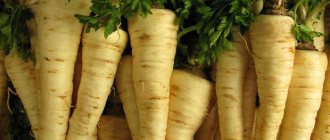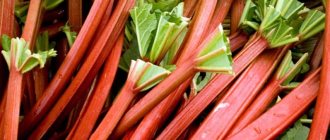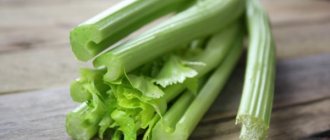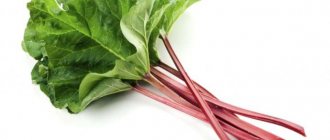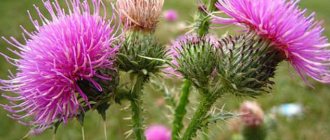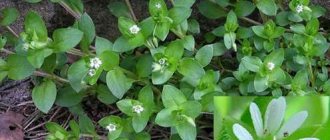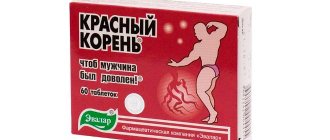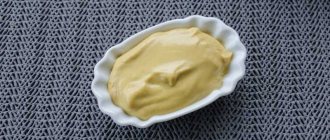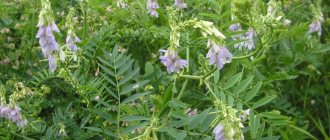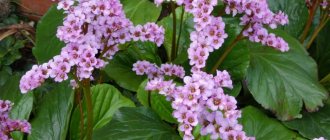Description
Rhubarb is inconspicuous in appearance, it looks like a weed, is considered a vegetable, and is used in cooking and medicine. Its homeland is Central China. Descriptions of this plant are found in herbal books written long before our era.
Rhubarb is a large perennial herb that grows up to 3 m in height. It has branched, thick rhizomes. The stems are annual, thick and straight, hollow inside, sometimes grooved. The leaves are large, with long petioles. At the end of the stem there is a large paniculate inflorescence. The flowers are white, greenish, sometimes pink or red.
Additional information about growing rhubarb, as well as its varieties, can be obtained from this article.
Areas of use of rhubarb:
- Cooking. In rhubarb, only the stems are edible; the leaves and roots are not eaten - they contain poison. Rhubarb is a universal product. Jams, ice cream, jellies, puddings, kvass, jelly, and various desserts are prepared from its stems. Rhubarb is added to vinaigrette, salads, borscht, pickles, sauces and other dishes. Rhubarb stems have a mildly sour taste, so they eat it with added sugar. When a vegetable is stewed in sugar syrup, it releases a lot of juice - almost no water is required.
- Ethnoscience. Rhubarb has long been used in Tibetan and Chinese medicine. Today, many effective recipes for the gastrointestinal tract and tonics are prepared on its basis.
- Cosmetology. Rhubarb juice is a great alternative to foundation. It hides minor imperfections and makes the skin a little “tanned”. Helps with vitiligo, evens out the overall tone of the epidermis, whitens the skin.
Rhubarb belongs to the buckwheat family. There are about 20 species of rhubarb that interbreed easily with each other, making them difficult to isolate and identify.
Botanical description of rhubarb
Rhubarb (rheum officinale) is a herbaceous perennial belonging to the Buckwheat family (Polygonaceae), which grows in height up to 2.5 - 3.0 m. In the first season, rhubarb grows a strong and strong root, and only then begins to develop rhizome. With each season, the rhizome grows more and more, lateral roots more than 1.0 m long diverge in different directions. Tubers also grow on the rhizome.
The basal foliage has long petioles, wide, heart-shaped, dissected at the edges. The foliage growing on the stems is much smaller, simpler in shape, and grows on short petioles. The flowers are small in size, collected in paniculate inflorescences, most often bisexual, growing in the axils of the upper foliage, which is boat-shaped. The perianths are simple in shape, have 6 petals, smaller in size than the flowers themselves, less often - the same size. After the flowers are pollinated, the perianths dry out. During the flowering process, the peduncle begins to grow further. This perennial plant begins to bloom two to three seasons after planting. The fruits are triangular shaped nuts, brown in color with a red tint. Nuts have wings. Rhubarb blooms in the first ten days of July. The forms of garden rhubarb are very similar to their medicinal “relative”. This medicinal perennial is propagated by seeds.
Also read: Red nightshade (bittersweet): description, use in treatment, possible harm
Rheum officinale (or rhubarb) is native to the mountains of western China and eastern Tibet, but is found in Central Asia and some countries of the former Soviet Union. Prefers moist soils, prefers to grow in sunny areas, but does well in shaded areas.
In many European countries, this medicinal perennial is grown specifically for its medicinal raw materials.
Rhubarb officinalis is a herbaceous perennial belonging to the Buckwheat family.
Vitamins, minerals and calories
Rhubarb contains:
- valuable dietary fiber – from 3.2%;
- carbohydrates – up to 2.5%;
- proteins – about 0.8%;
- vitamins – A, K, group B, PP, E, C;
- microelements – iron, copper, selenium;
- macroelements – potassium, calcium, magnesium, sodium, phosphorus.
By eating 100 g of rhubarb, a person will receive the daily requirement of nutrients.
Rhubarb petioles also contain a lot of malic, ascorbic, nicotinic, folic, succinic, oxalic, citric and acetic acids, which are involved in metabolism and protect the body from free radicals. They promote bile formation and bile excretion. A large amount of organic acids is the reason for the sour taste of rhubarb.
Due to an overdose of oxalic acid, stones form in the kidneys. There is a lot of this acid in adult plants, so it is recommended to eat young rhubarb petioles - no older than 35 days.
Rhubarb contains two types of dietary fiber - soluble and insoluble. It has a low calorie content - only 13 kcal per 100 g of peeled stems. Useful for weight loss. But due to its sour taste, many rhubarb dishes and preparations are prepared with sugar, which significantly reduces their benefits.
Everything about rhubarb, its benefits and harms + recipes
Rhubarb can bring not only benefits, but also harm to the body, but if you use the right cooking recipes, you can get tasty and healthy dishes.
Technically it is a vegetable, although it is used in cooking as a fruit: it is used to make pies, jam, pies, drinks and much more.
Read more about what rhubarb is, how it is useful and what dishes can be prepared from it on rblogs.ru.
What is rhubarb and how is it eaten?
Rhubarb is a perennial herb grown for its succulent, pinkish-red edible stems (petioles) with a tart, sour flavor.
It is native to Siberia and is now widespread in many regions of Europe and North America.
Rhubarb is rarely eaten raw. It is almost always cooked, sweetened with sugar, or used as one of the ingredients in recipes.
The petioles are the only edible part of the plant; its leaves are poisonous because they contain large amounts of a substance called oxalic acid. This compound is harmful if ingested in large quantities.
general description
Botanically, rhubarb belongs to the family Polygonaceae, genus Rheum and is known by the scientific name Rheum rhabarbarum. The plant prefers cool climates.
Rhubarb stems are bright pink, but they also come in light pink and even pale green. The hue is not a sign of ripeness or sweetness. Rhubarb comes in different varieties, and all have almost the same taste and aroma.
How and where it grows
Rhubarb is one of the easiest plants to grow and can grow in one place for 10-15 years. It usually reproduces by dividing rhizomes.
A mature plant has stems 30 to 50 centimeters long and broad, heart-shaped, dark green leaves. It is these stems (petioles) that are used (after cutting off their upper leaf part) in cooking.
They are ready for harvest starting from the second year, when they reach sufficient thickness - from 2.5 to 5 cm.
What does it smell and taste like?
Fresh rhubarb stems have a rich, sweet and sour taste. Their acidity is mainly due to the high content of malic and oxalic acids. When raw, rhubarb tastes very tart, so it is almost always cooked with a generous helping of sugar.
Where to buy and how to choose
Fresh rhubarb stems can be purchased at markets in most parts of the country from April to July.
If you are growing it in your garden, pluck the petiole by grasping it at the base while pulling and twisting it. Immediately separate the stem from the leaf part. Rhubarb greens contain oxalic acid, as well as poisonous glycosides.
When shopping at the market, look for fresh, firm, crisp, bright red stems. Do not take dull, flaccid petioles with spots on the surface.
How and how much to store
Fresh rhubarb has a fairly short shelf life. For storage, the petioles are wrapped in a plastic bag and placed in the refrigerator. At a temperature of 0 °C and a relative humidity of 95%, they remain fresh for 3-5 days.
Rhubarb stems can be cut into pieces and frozen for 6-8 months. They will be a little soft after thawing, but this doesn't really matter since they will still need to be cooked further.
Use in cooking and recipes
Rhubarb recipes most often require first chopping and then stewing, frying, or otherwise processing the chopped stalks at high temperature. Typically a small amount of water and sugar or alternative sweeteners are added. This sweetens the sour petioles. Pairing rhubarb with another naturally sweet fruit helps cut down on added sugar.
To prepare the rhubarb dish:
- Trim the ends of the stems with a paring knife.
- Wash them in cold running water, gently rubbing the surface with your fingers.
- Cut the rhubarb into pieces 1-2 cm in size. If the petioles are too mature, remove the hard fibers (threads).
Here are some useful tips on what rhubarb goes with:
- stems are used for making sauces, canned food, jellies, preserves, jams, syrups, sorbets, compotes, kvass, juices;
- rhubarb is best known for its delicious pie recipes;
- pies, pancakes, pancakes, charlottes, muffins, strudels are prepared with it;
- Rhubarb goes great with strawberries. Pie with these two ingredients is the most popular baking recipe, but there are many other options, such as donuts, brownies and cakes;
- it is used to make homemade wine.
Rhubarb and strawberries are a popular combination in baking recipes.
Rhubarb and cheese salad recipe
This is a delicious and simple recipe for making a salad of rhubarb, walnuts and Adyghe cheese. It turns out original and piquant.
What you will need:
- 300 g rhubarb petioles, cut into 2 cm pieces;
- ¼ cup honey;
- ½ tbsp. walnuts;
- 2 tbsp. l. olive oil;
- 2 tbsp. l. balsamic vinegar (preferably white);
- coarse salt and ground pepper to taste;
- 4 bunches of arugula (about 400 g in total), tough ends removed;
- ½ cup Adyghe cheese, crumble.
Cooking method:
- Preheat the oven to 200 degrees.
- Place rhubarb mixed with honey on a baking sheet. Roast on the top rack for up to 5 minutes to soften slightly. Let cool.
- On another baking sheet, toast the walnuts on the lower rack until fragrant, 5 minutes. Cool, then grind in a food processor.
- In a large bowl, combine oil and vinegar and season with salt and pepper.
- Add arugula, honeyed rhubarb, walnuts and sprinkle with cheese.
Delicious pie with rhubarb and strawberries
This is a classic American rhubarb pie recipe topped with a beautiful wicker lattice.
Ingredients:
- 6-8 tablespoons flour;
- 2 cups sugar;
- 1 tablespoon butter, cut into small pieces;
- 4 tbsp. chopped rhubarb;
- 2 tbsp. strawberries, cut into pieces.
Cooking instructions:
- Preheat the oven to 200ºC.
- Mix flour and sugar in a large bowl. Add rhubarb and stir.
- Divide the dough into 2 parts, roll out one of them to a thickness of 0.7-1 cm and place in a round baking dish.
- Place rhubarb and strawberries on top and add butter.
- Roll out the second part of the dough and cut into strips, decorate the top of the pie, intertwining them with a lattice. Trim the edges and crimp the top and bottom of the dough together.
- Place the pie on a baking sheet and bake for 10 minutes.
- Reduce heat to 170ºC and bake for a further 30-50 minutes until the filling begins to bubble. Cover the edges with foil if the cake is baking too quickly.
Chemical composition and calorie content
Nutritional value per 100 g of fresh rhubarb (Rheum rhabarbarum):
- Calories: 21 cal.
- Carbohydrates: 4.54 g
- Dietary fiber: 1.8 g
- Fat: 0.20 g
- Protein: 0.90 g
| Vitamins and minerals | Quantity | % of daily value |
| Folates | 7 mcg | 2 |
| Niacin | 0.300 mg | 2 |
| Pantothenic acid | 0.085 mg | 1,5 |
| Pyridoxine | 0,024 | 2 |
| Riboflavin | 0,030 | 2 |
| Thiamine | 0,020 | 2 |
| Vitamin A | 102 ME | 3,2 |
| Vitamin C | 8 mg | 12 |
| Vitamin E | 0.27 mg | 2 |
| Vitamin K | 29.3 mcg | 24 |
| Sodium | 4 mg | 0,5 |
| Potassium | 288 mg | 24 |
| Calcium | 86 mg | 8,5 |
| Copper | 0.021 mg | 2 |
| Iron | 0.22 mg | 3 |
| Magnesium | 12 mg | 3 |
| Manganese | 0.196 mg | 8,5 |
| Phosphorus | 14 mg | 2 |
| Selenium | 1.1 mcg | 2 |
| Zinc | 0.10 mg | 1 |
| Beta carotene | 61 mcg | — |
| Lutein-zeaxanthin | 170 mcg | — |
The calorie content of 100 g of fresh rhubarb petioles is only 21 calories. This vegetable contains vital phytonutrients: dietary fiber, polyphenolic antioxidants, minerals and vitamins. It has no saturated fat or cholesterol.
The stems contain several B vitamins: folate, riboflavin, niacin, vitamin B-6 (pyridoxine), thiamine and pantothenic acid.
Red petioles contain more vitamin A than green varieties. They also contain small amounts of polyphenolic flavonoid compounds such as beta-carotene, zeaxanthin and lutein.
In the human body, they are converted into vitamin A, a powerful natural antioxidant that maintains the integrity of the skin and mucous membranes. It is also important for healthy vision.
Natural foods rich in vitamin A protect against lung and oral cancer.
Like other green vegetables (kale, spinach, etc.), rhubarb stems also provide adequate amounts of vitamin K (29.3 mcg per 100 g, or about 24% of daily recommended intake). It plays an important role in bone health by helping to strengthen them.
Adequate levels of vitamin K in the diet help limit damage to neurons in the brain, and thus help in the prevention and treatment of Alzheimer's disease.
The petioles also contain beneficial minerals such as iron, copper, calcium, potassium and phosphorus. However, most of these minerals are not absorbed by the body because they are converted to an insoluble form by oxalic acid, which is then excreted from the body.
Rhubarb contains more calcium than the same amount of milk, but in a form that the body cannot easily absorb.
Benefits and harm to the body
The average amount of rhubarb eaten daily, from which the benefits will exceed and neutralize its harm, is 2/3 cup. In large doses, it can be dangerous to health; see rblogs.ru for more details.
Beneficial features
- Relieves constipation. It has a laxative effect due to its tannin content and large amounts of dietary fiber.
- Strengthens bones. Rhubarb contains a good dose of vitamin K, which improves bone metabolism and helps prevent fractures and osteoporosis.
- Useful for weight loss.
Rhubarb lowers bad cholesterol levels, and since it is a low-calorie food, it fits well into a weight loss diet. - Helps improve vision. Rhubarb contains lutein and vitamin C, both of which work well for eye health.
- Preserves the beauty of the skin.
Vitamin A in this vegetable neutralizes free radicals and slows down aging and the appearance of wrinkles. - Supports brain health. Vitamin K in rhubarb limits neuronal damage to the brain and thereby prevents Alzheimer's disease.
- Beneficial for the female body.
It contains phytoestrogens, which relieve symptoms of PMS (premenstrual symptoms), and in the case of menopause, relieve hot flashes, reduce sweating, fatigue and sexual problems, improve sleep, mood, and quality of life.
Useful and healing properties
Most often, rhubarb petioles are used in folk medicine - they are tasty and contain a lot of useful substances. Rhubarb stems are used as a food and medicinal additive. The plant helps with constipation, menopausal symptoms, and allergies.
The effect of rhubarb petioles on the body:
- Antitoxic. Absorbs poisons and toxins, decay products. The plant can eliminate the consequences of any intoxication. Helps with hangover syndrome, used for hepatitis and poisoning.
- Hypoglycemic. Helps reduce blood sugar and helps maintain stable levels in diabetes.
- Antibacterial and healing. Used to remove pimples, blackheads, vitiligo, boils, and rashes of various natures.
- Vitaminizing and restorative. Increases immunity. Used in the fight against alopecia - hair loss. Strengthens nails and hair follicles.
- Anti-inflammatory. Relieves inflammation in arthritis, gout, diseases of the appendages.
A brief description of the plant itself, the benefits and harms of rhubarb, as well as how to store it is described in the program “Live Healthy”:
The effect of rhubarb is so multifaceted that it has long been used to treat a variety of diseases. This plant is included in many healing preparations - it has a positive effect on almost all body systems:
- Digestion. Affects appetite and normalizes stomach acidity. Useful for gastritis and ulcers of the mucous membrane, normalizes intestinal microflora. Due to its anti-inflammatory properties, rhubarb is used to treat hemorrhoids, colitis, and proctitis.
- Leather. The plant has a whitening effect. It is used to eliminate pigmentation and remove scars. The healing properties of rhubarb make it possible to treat eczema, psoriasis, and trophic ulcers with its help.
- The immune system. Helps to get stronger after pneumonia, tuberculosis, large-scale blood loss. It invigorates and adds strength, improves metabolism - that’s why the plant is included in weight loss preparations.
- The cardiovascular system. Reduces the risk of heart attacks and strokes.
- Eyes . Due to its rich carotene content, it has a positive effect on vision.
Rhubarb is especially valued for its laxative, antiseptic and choleretic effect. Preparations with such properties are made from the rhizomes of the plant.
Chemical composition of rhubarb roots
The use of rhubarb root in folk medicine is due to the rich composition of the natural product. 100 grams of roots contain many useful substances:
- Protein – 1.3 g;
- Lutein – 0.19 mg;
- Sugars – 4.7 g;
- Beta-carotene – 0.07 mg;
- Fat – 0.1 g;
- Fiber – 2.3 g;
- Vitamin K – 0.03 mg;
- Iron – 0.35 mg;
- Vitamin B3 – 0.5 mg;
- Zinc – 0.15 mg;
- Vitamin C – 11 mg;
- Calcium – 92 mg;
- Manganese – 0.3 mg;
- Vitamin A – 120 mg;
- Magnesium – 15.5 mg;
- Omega-6 acids – 0.11 mg;
- Potassium – 297 mg;
- Sodium – 4.3 mg;
- Vitamin E – 0.6 mg;
Also, the frequently used rhubarb root for hepatitis C contains 0.03 mg of pantothenic acid and 0.1 mg of folic acid.
Chemical composition of rhubarb roots
How to take, recipes
To make the most of the healing properties of rhubarb, it is consumed not only in its raw form, but also in concentrated form. Prepared from petioles and rhizomes:
- Tinctures. For the treatment of diseases of the digestive system, gall bladder, anemia.
- Infusions. They have antiseptic and anti-inflammatory properties. They are used to treat colds, runny noses, sinusitis, and constipation.
- Decoctions. Used for high blood pressure in hypertensive patients. They perform well in the fight against hepatitis.
- Powder. It has both a diuretic and laxative effect (depending on the dosage), and regulates the menstrual cycle.
Recipe No. 1. Infusion for constipation. Rhubarb often causes addiction to the body; to prevent this from happening, the infusion is alternated with pharmaceutical preparations. How to prepare and take:
- Crush dried rhizomes (2 tbsp) in a mortar.
- Pour boiling water (250 ml) over the resulting powder.
- Leave for 10-15 minutes. Strain.
- Before going to bed, drink 1/3 of the received volume.
Recipe No. 2. Diarrhea powder. Useful for flatulence, intestinal cramps and dysbacteriosis. Preparation and use:
- Grind the dried roots in a coffee grinder until the consistency of a fine powder.
- Take orally 2 times a day. Dosage – 1-2 g. Children are given 0.1 g (at the tip of a knife). Drink with water. To improve the taste of the powder, you can mix it with honey.
Recipe No. 3. Decoction for hypertension. Made from dry petioles. Has a general strengthening effect. Preparation and use:
- Pour boiling water (300 ml) over dried petioles (2 tbsp).
- Leave until cool. Strain.
- Drink during the day, dividing the entire volume into three doses - you get 1/2 cup each.
Recipe No. 4. Tincture for diarrhea. How to prepare and take:
- Chopped roots (2 tbsp) are poured with vodka (500 ml).
- Insist for two weeks in the dark.
- After straining, store in the cold.
- Take only adults - if there are no contraindications, one teaspoon at a time. Take twice a day, before meals.
Recipe No. 5. Decoction for hepatitis. Used to treat various liver diseases. Preparation and use:
- Rhubarb root powder (2 tbsp) is poured with boiling water (500 ml).
- Boil for 15 minutes over low heat.
- Leave for 6 hours. Strain.
- Take a tablespoon 2-3 times a day - before meals. The course of treatment is 30 days.
Recipe No. 6. Choleretic infusion with celandine and dandelion. Preparation and use:
- The roots of rhubarb, dandelion and celandine are mixed in equal parts. A tablespoon of the mixture is poured with boiling water (250 ml).
- Leave until cool. Strain.
- Take before meals - 1/3 cup 3 times a day, as a choleretic agent.
Recipe No. 7. Medicine for vitamin deficiency. An excellent preventative in winter. Preparation and use:
- The rhubarb petioles are peeled and washed.
- After drying the washed petioles, squeeze the juice out of them.
- Add honey or sugar.
- Drink one and a half glasses of juice per day.
Recipe No. 8. For oily hair. Preparation and use:
- Ground dry rhubarb roots (250 g) are poured with natural white wine (500 ml).
- Cook over low heat until the volume is reduced by 50%. Cool.
- The mass is applied to damp hair, spreading over the entire length, for half an hour.
Recipe No. 9. For freckles. Preparation and use:
- The petioles are ground and the juice is squeezed out.
- Add ground oatmeal (1 tbsp) and homemade cream (1 tbsp) to fresh juice (2 tbsp).
- The mask is applied to the face after cleansing and steaming the skin for 20 minutes.
- The mixture is washed off with cool water.
Recipe No. 10. For acne. Preparation and use:
- Fresh petioles are crushed.
- Mix chopped rhubarb (2 tbsp.) with glycerin (1 tbsp.) and egg white (1 pc.).
- Apply to steamed skin for 15-20 minutes.
- Wash off with cool water, wipe with an ice cube. The procedure is done every other day.
Harm and contraindications
Rhubarb, having a whole range of beneficial effects, acts like a medicine, which means it cannot be consumed uncontrollably. Rhubarb leaves (petioles) are not recommended for people with kidney stones - due to the deposition of oscalate salts.
Rhubarb is also contraindicated for:
- individual intolerance;
- gallstones;
- peritonitis;
- rheumatism;
- cholecystitis;
- pancreatitis;
- inflammation of the genitourinary system;
- diabetes mellitus;
- gastric and hemorrhoidal bleeding.
Rhubarb should be used with caution when:
- increased acidity;
- stomach ulcer;
- liver cirrhosis.
It is not recommended to use petioles and dishes/preparations prepared from them for diarrhea. In this state, rhubarb can have a stimulating effect - there is a risk of dehydration.
Pharmacy release forms of rhubarb
Pharmacists make the following medicines from rhubarb:
- rhubarb extract;
- syrups;
- powder;
- pills.
Each pharmaceutical form is accompanied by instructions for use, which must be followed when taking any of these medications.
All these medications are prescribed by a doctor and used strictly in the dosages prescribed by a specialist.
Also read: Healing properties of calendula vulgaris
Side effects
As a food product, rhubarb is considered safe and does not cause side effects. But at significant therapeutic doses it can cause problems.
The risk of side effects increases if rhubarb preparations - infusions, decoctions, etc., are taken for more than 8 days. Long-term treatment with rhubarb threatens:
- heart rhythm disturbances;
- formation of kidney stones;
- pain in the back or stomach;
- dizziness;
- irritation of the skin and mucous membranes;
- tenesmus (an ineffective urge to urinate/defecate, accompanied by pain);
- vomiting;
- diarrhea;
- a rush of blood to the pelvic organs.
Special cases
There are cases when rhubarb is not recommended to be consumed in any form, or is permitted with reservations and restrictions. Rhubarb and its preparations require careful use in childhood and old age, during pregnancy and lactation.
Pregnant and nursing
Pregnant women are allowed to eat rhubarb only when it is thermally processed - as part of jelly, desserts and other dishes.
The stems are rich in vitamin K, and therefore are extremely useful for women suffering from hypertension. And the high calcium content turns out to be useful for the successful formation of the musculoskeletal system of the unborn child.
By eating rhubarb, pregnant women will be able to:
- maintain strong bones and teeth;
- suffer less from colds and acute respiratory viral infections;
- cure diarrhea and constipation (in small quantities rhubarb has a strengthening effect, in large quantities it has a laxative effect).
During feeding, rhubarb should not be consumed in any form - there is a risk of disrupting protein metabolism.
Childhood
A baby can try rhubarb for the first time from the age of one. The vegetable is especially useful for children prone to constipation. But rhubarb is given only in boiled form - for example, in the form of compote. Start with a few drops, gradually increasing the dose and monitoring the reaction. For older children, you can offer syrup or jelly.
In children under 12 years of age, rhubarb is given with caution and in small quantities.
Procurement of raw materials
When harvesting petioles, do not use a knife - it can easily damage the growing point. The stems are broken out by hand, making careful rotational movements in different directions.
It is better to use a young plant to collect leaves. When harvesting old leaves, the petioles are cleared of the top layer. Rhubarb is dried, frozen and canned. In addition to petioles, rhubarb rhizomes can also be harvested.
Drying roots and petioles
Rhubarb roots are dried immediately after collection. They are collected from plants no younger than 4 years old - during this period many useful substances will accumulate in the roots. Preparation order:
- Rhizomes are dug up from September to October.
- Having cut off the above-ground part, the roots are washed and cut into pieces of 10 cm.
- Dry in the shade, in the air - the roots give up moisture and wither.
- Dried roots are dried in dryers at 60 °C.
The finished product has a dark brown surface and a yellow-pink core. Dried roots have a specific smell and bitter-astringent taste.
Petioles, dried and crushed, are used in medicine and cooking. They are added to salads, sauces, and baked goods. Preparation order:
- Having broken off the leaves and collected them into a bunch, remove the leaf blades so that only petioles remain, which are washed and cut into pieces.
- After withering the petioles in the air - under the sun, for 2 days, they are dried in the oven. Dry for 2 hours at 90 °C.
- Dried raw materials are placed in glass jars whole or in crushed form.
Freezing
Freezing allows you to preserve the maximum of useful substances in rhubarb, which are inevitably lost during heat treatment.
Some housewives blanch the petioles to preserve their red color. But this procedure reduces the usefulness of the product.
Freezing procedure:
- Wash the petioles in cold water.
- Dry on paper towels.
- Cut into cubes and, spread out on a baking sheet, place in the freezer for 1 hour.
- After pouring the cubes into a plastic bag and removing the air from it by squeezing, tie it tightly. Store in the freezer.
Rhubarb is not only a tasty product, but also a raw material for traditional medicine recipes. By growing and preparing rhubarb, you can prepare healing and preventive remedies that are not inferior in effectiveness to expensive pharmaceutical drugs.
0
0
Copy link
Harvesting and storing rhubarb root
The harvesting of raw rhubarb - its roots - is carried out at the time of their full ripening. Usually this happens no earlier than 4 years from the moment rhubarb is planted in open ground. But the greatest amount of useful substances and full ripeness of the root system are observed in the 6th year. Rhubarb roots are pulled out in the fall . They should be cleaned of soil and other dirt, washed thoroughly under running water, cut into small pieces and placed to dry in the sun. Hardened pieces of roots are strung on thick threads and hung to dry in the shade. You can also dry the raw materials in special dryers at a temperature of about 57 - 60 degrees.
Also read: Common moth: description and medicinal properties of the plant
The finished raw material has a peculiar aroma, and the taste is slightly bitter, slightly astringent. When dried, the roots lose up to 10–12% in weight.
Dried petioles should be used within a short time, but dry roots can be stored for up to 4 - 5 seasons in a glass container under a lid or in canvas bags in a room with low humidity. Subsequently, the roots lose their healing properties.
Procurement of rhubarb raw materials - its roots - is carried out at the time of their full ripening
